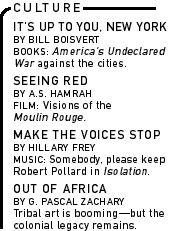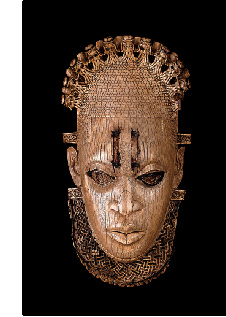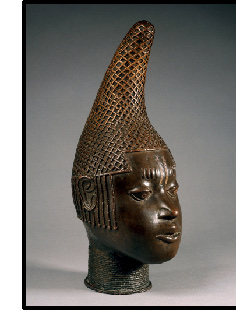

|

|

|

|
|
|
| |
|
|||
|
Nearly a half century since the decolonization of Africa, the question remains: Why is Europe still the best place to view or buy traditional and tribal African art? While the world has started to pay attention to the collapse of health care systems in sub-Saharan Africa--and the concomitant spread of AIDS and the resurgence of "vanquished" diseases such as malaria and tuberculosis--little is said about the continent's cultural collapse. The governments that have plundered the continent's resources also have ignored the vast cultural treasures in their countries. Only African music retains a firm footing, because of its commercial base and vague attraction to listeners of Western pop. But Africa's great traditions of sculpture, mask-making and textile design are poorly
recognized at home. Even behemoths such as Nigeria, Africa's most populous nation, or South Africa, the richest nation of black Africa, boast no museums where visitors are presented with anything like the breadth, diversity and sheer quality of the art produced across the continent. Instead, museums in Africa tend toward the local and disconnected. And that's in places where museum curators aren't selling off pieces themselves or conspiring with thieves. To get a feel for the immense diversity of tribal African art requires a visit not to Africa, but to London, Paris, Berlin, Brussels, New York, Washington or Los Angeles. This irony is all the more poignant because after centuries of denigrating tribal African art as mere anthropological curiosity, Western collectors and museum curators are now among its most devoted admirers--and they have helped make it a thriving business. While African statues and masks once went for a song, allowing shrewd collectors to assemble a gallery of gems on the cheap, this is no longer so. Quality pieces, dating from the 19th or early 20th century, routinely sell for tens of thousands of dollars. A glossy catalog for an upcoming auction in Paris, for example, advertises more than 600 objects that represent the bulk of the collection of a recently deceased French collector, Hubert Goldet. The finest pieces, such as a Baule mask from the Ivory Coast or a finely carved ritual table from the Congo, are expected to sell for more than $100,000 each, and many other pieces should fetch more than $10,000. These are high prices indeed for tribal art that, in the main, began to circulate as colonial booty. But this legacy of cultural plunder carries an ambiguous morality--in part because African elites never valued this art and took few steps to preserve it themselves. This dilemma remains largely unacknowledged even as the cultural and monetary value of African art booms among a select group of Europeans and Americans. Among the plunder from Africa, during the "great scramble" for control over the continent in the late 19th century, art counted among the highest prizes of imperialism. As the fruits of the looting of central Africa in particular began showing up in Europe, important artists took notice. Early in the 20th century, Africans inspired a bevy of Europeans, including Pablo Picasso and Georges Braque, both of whom admired what was then viewed as the "primitive" or instinctive qualities of African sculpture and masks in particular. Max Ernst created bronze sculptures that bore striking resemblances to Africa's wooden statues. The Italian sculptor Alberto Giacometti's elongated and misshapen human figures owe a debt to African conceptions of beauty. (This link between modern art and tribal Africa is well documented in France's National Museum of Modern Art and in the Picasso Museum, where African art owned by European artists is displayed alongside their own work, to revealing effect.) Despite this influence, the 20th-century art world did not grant African art the kind of rarified status given to visual arts in the West. Africans, it was believed, lacked the intellectual capabilities and the emotional depth to produce art that matched the best of the West and Asia. With the wave of independence throughout Africa in the late '50s and early '60s, these racist attitudes began to change. Black pride, while chiefly seen as an African-American reaction to centuries of segregation and subordination, had its parallels among thinkers and activists in Africa. Indigenous expression took on fresh value. Some Europeans, meanwhile, began to idealize the African aesthetic, granting the status of high culture to what were once just seen as religious artifacts of tribal life and drawing important distinctions of style and skill between tribes. Indeed, dozens of African tribes have significant--and still living--traditions in the visual arts: the Fang or Kuba in the Congo, the Asante or Fante in Ghana, the Dan or Baule in Ivory Coast, or the Dogon or Bambara in Mali are just a few examples. (For an introduction, gape at the gorgeously illustrated 1998 volume by Jean-Baptiste Bacquart, The Tribal Arts of Africa.) But after decades of steady interest in African tribal art by collectors, quality pieces no longer turn up consistently--and pieces made more than a century ago are exceedingly rare. Still, there are exceptions: The massive war in the Congo has boosted supply. As a recent U.N. report documented, the invading armies of Uganda, Rwanda, Angola and even Zimbabwe know enough not to stop at looting just diamonds and timber from the Congo; tribal art, often stolen directly from terrified villagers, also makes up part of the war booty. Looted Congolese pieces can quickly make their way to places as far away as the United States. Today's looters are only carrying on a dubious European tradition. The British
The African Galleries contain more than 600 pieces, organized thematically, and mainly dating from the 19th and 20th centuries. The exhibit, which will be refreshed from the museum's collection about every two years, also contains a few contemporary pieces, such as a hippopotamus mask by the Nigerian artist Sokari Douglas Camp. But most of the objects are tribal art, such as a Kuba royal statue from the early 18th century, the late 19th-century dance shields by the Kikuyu of Kenya or the elephant mask made of cotton and cowrie shells in Cameroon early last century. Undoubtedly the centerpieces of the British Museum's collection are the arresting brass casts from Benin, a legendary African kingdom that is now part of contemporary Nigeria and reached its peak in the 15th century. The most special of these is a Yoruba brass head, one of the so-called "Ife" castings. Benin casts are prized by West Africans, because they were made using techniques unknown to Europeans at the time. Indeed, the techniques were so superior to European metalwork that for a long time, art experts in the West insisted that the Benin people could not have learned this form of casting on their own. They said the casts must be the work of a Greek colony, perhaps even the mythical Atlantis. It wasn't until after World War II that the senior Africanist at the British Museum declared that the Ife castings certainly predated any European influence on Benin's artists. In an 1897 British invasion of what today is Nigeria, soldiers seized many of these casts, including what is now an entire wall on display in the galleries. "These objects should be returned," says Adama Gaye, publisher of the London-based West Africa magazine. "African countries are mature enough to manage this art, and it belongs to them." John Mack, the senior "keeper" of artifacts at the British Museum and an expert on African art who directed the creation of the new African Galleries, disagrees. Mack says that most African countries still lack the skills and resources to safeguard their most precious objects: "In many ways, these are better off with us." Some Africans themselves agree, he says, citing the example of the Kuba tribe, some of whose objects are on display at the galleries. "The Kuba chief was here at the opening, and he plainly said that he was happy these objects weren't in the Congo, where they could be stolen," Mack says. The chief even complained that prized tribal art recently donated to a Congo museum has already been stolen. The British insist that more African art is likely to shift to
the West, rather than return home, if only because European and
U.S. museums have the resources and expertise to preserve and safeguard
these objects. This view is hard to dismiss. The reality is that
in sub-Saharan Africa at least, governments have more pressing needs
than the task of art presentation and preservation. This is doubly
tragic, because when Africa is dependent on the West for management
of the very art that Africans can proudly call their own, it is
Westerners who define what makes this art beautiful and valuable.
G. Pascal Zachary is an In These Times contributing editor and the author of The Global Me, on globalization, society and culture. He can be reached at Gregg.Zachary@wsj.com.
|



